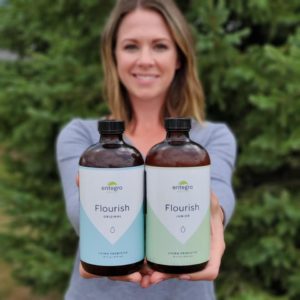Immune System + Microbiome
The innate, also known as non-specific, immune system is the first line of defense against pathogens and works in a couple of general ways.
Physical Barrier
Primarily, the top layer of all skin is lined with a special type of cell called epithelial cells. These special cells cover both the outside of the body and the line of the gastrointestinal tract from top to bottom. In the gastrointestinal tract, they are tightly packed together so large pathogens are not able to sneak through the intersections, also known as tight junctions. This prevents them from entering the bloodstream and lymph system.
Our skin plays an important role in temperature regulation and dehydration prevention. The sense of touch keeps the body from dangerous situations that may cause burns or pinching. These openings are an entrance for bacteria into the body.
The inside epithelial cells line the GI tract openings from top to bottom and protect our bodies from the outside world. These cells produce a thick mucus that make it difficult for pathogens and dirt to attach. At the same time, the mucus prevents dehydration of the various organs it covers. In the gut, there are two mucus layers. One tight to the epithelial cells and one loose layer where the bacteria live. The mucus provides a place for the microbiome to live and in turn, the microbiome supports the integrity of the mucus layers.
Chemical Barrier
The epithelial mucus also contains different types of chemicals that protect us from pathogens and infection. The stomach mostly maintains a low pH that prevents many viruses and pathogenic bacteria from surviving as they pass through. Flourish and Flourish Junior are fermented in such a way to keep the beneficial bacteria in the environment that they create. This low pH is able to make it through to the colon. From there, they can take up residence and do their beneficial thing.
Partnership
The bacteria that cover our bodies inside and out work together with our immune system. The immune system and gut microbiota have grown up together. That’s why the body doesn’t attack the microbiome that has developed within. A microbiome that is diverse and full of beneficial bacteria make it more difficult for pathogenic bacteria to make a home in your gut through competition for the same resources and space.
The friendly bacteria in the gut provide direct protection to the mucosal lining. In turn, the bacteria provide a secure barrier to prevent large particles to pass through to the bloodstream and lymph system. The mucosal barrier also contains just about half of the Peyer’s patches of the body. These Peyer’s patches play a major regulatory role of the immune system.
There are many things we can do to make our friendly bacteria happy, and therefore boost our immune system!
Some examples include:
- Include fiber-rich foods in your diet – The minimum daily fiber recommendation for men is 38 grams and for women, 25 grams. If you currently have a low fiber diet, add fiber gradually over a couple days is ideal. This will reduce negative side effects such as bloating and gas. Examples of high fiber foods include fruits & vegetables, lentils, whole grains, nuts, and seeds.
- Get adequate sleep – It’s not always possible, but strive to make sleep a priority.
- Move your body – Exercise supports a diverse microbiome and appears to increase short-chain fatty acids. Learn more about exercise and the microbiome in a previous blog here.
- Take a high-quality probiotic daily and eat fermented foods – Flourish Original and Junior contain living
 good bacteria. Each ultra-concentrated dose has the beneficial metabolites produced by the bacteria as they have grown as well. This includes short chain fatty acids, bioactive peptides, amino acids, enzymes, and minerals.
good bacteria. Each ultra-concentrated dose has the beneficial metabolites produced by the bacteria as they have grown as well. This includes short chain fatty acids, bioactive peptides, amino acids, enzymes, and minerals.
Written by Lorilyn Van Dyke, Entegro Health

 New customers! Get 11% OFF your first Flourish order with Code FRESHSTART11
New customers! Get 11% OFF your first Flourish order with Code FRESHSTART11